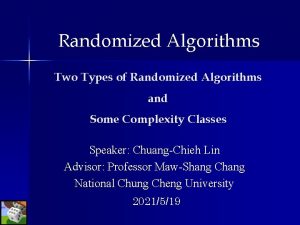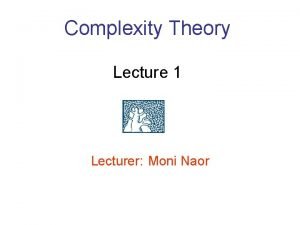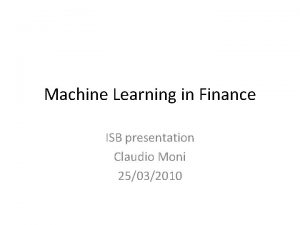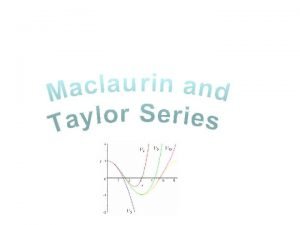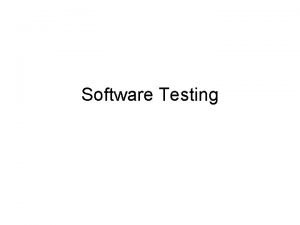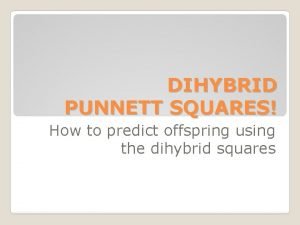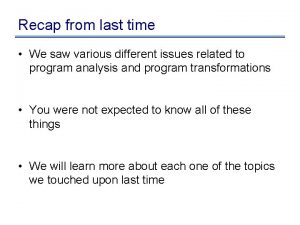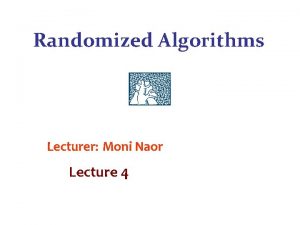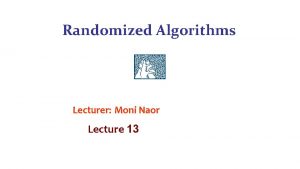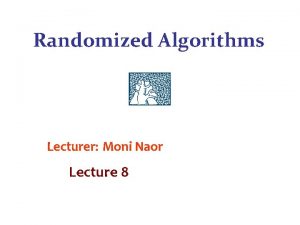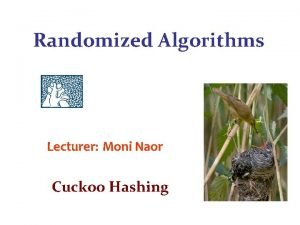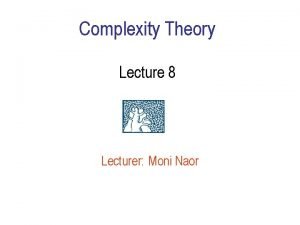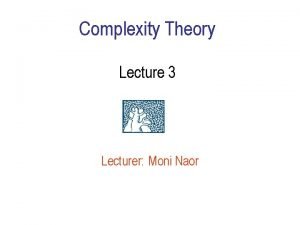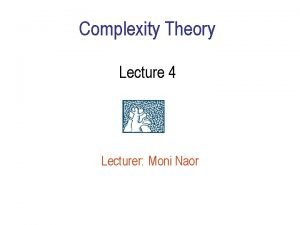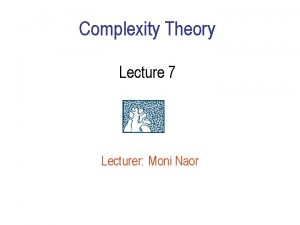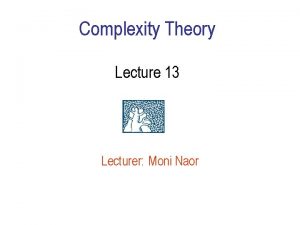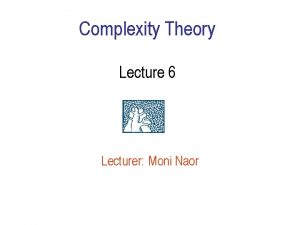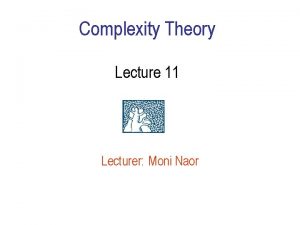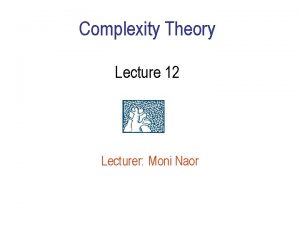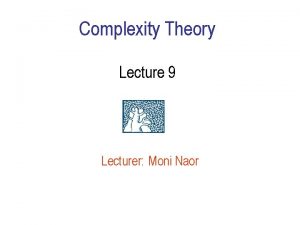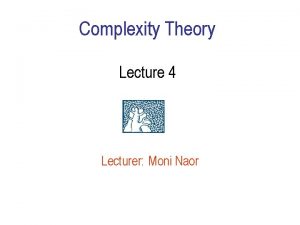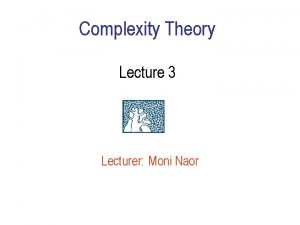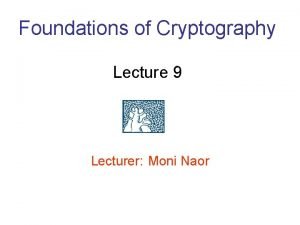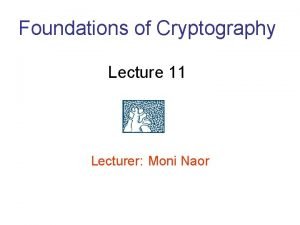Randomized Algorithms Lecturer Moni Naor Lecture 12 Recap









































- Slides: 41

Randomized Algorithms Lecturer: Moni Naor Lecture 12

Recap and Today Recap • Cuckooh Hashing Today • Cuckoo Hashing • Bloom Filters • Random Graphs • Limited Randomness and the Braverman’s Result concerning AC 0

The Setting • Dynamic dictionary: – Lookups, insertions and deletions – Dynamic vs. static • Performance: – Lookup time – Update time – Memory utilization – Related problems: § Approximate set membership (Bloom Filter) § Retrieval 3

Major Problem in Hashing Based Schemes: Collisions • Hash Tables – Hash Function h Table T – Direct access to memory § Element x should ``reside” in T[h(x)]. . . Unless |T| ≥ |U| U T Collision: two different elements with the same value under h

Dealing with Collisions • Lots of methods • Common one: Linear Probing – Proposed by Amdahl – Analyzed by Donald Knuth 1963 • “Birth” of analysis of algorithms – Probabilistic analysis 5

Linear Probing To insert x: try location h(x) in table T – If occupied, try h(x)+1 – and if occupied, try h(x)+2 – Until we find a vacant place Looking for x: • Similar to insert: search until finding x or a vacant place. 6

Linear Probing: situation after a while 7

Cuckoo Hashing: Basics • Introduced by Pagh and Rodler (2001) • Extremely simple: – 2 tables: T 1 and T 2 d §Each of size r = (1+ε)n – 2 hash functions: h 1 and h 2 c x a – Check in T 1 and T 2 T 1 Where is x? h 2(x) . . . • Lookup: h 1(x) t y b z T 2 8

Cuckoo Hashing: Insertion Algorithm To element • insert To insert x: x, call Insert(x, 1) – Puti): in first location and displace residing Insert(x, if needed 1. Put xelement into location hi(x) in Ti 2. If T–i[h was empty: return in its other location Put displaced element i(x)] 3. If – Ti[h y: do Insert(y, 3–i) i(x)] contained Until finding a element free spot d Example: T 1 e h 2(y) = h 2(a) . . . h 1(y) c x a. . . h 1(e) = h 1(a) t y b z T 2 9

Cuckoo Hashing: Insertion What happens if we are not successful? • Unsuccessful stems from two reasons – Not enough space § The path goes into loops – Too long chains • Can detect both by a time limit. 10

Cuckoo Hashing: Deletion • Extremely simple: – 2 tables: T 1 and T 2 §Each of size r = (1+ε)n d – 2 hash functions: h 1 and h 2 • As in Lookup: c x a T 1 Where is x? h 2(x) . . . – Check in T 1 and T 2 – Remove wherever found h 1(x) t y b z T 2 11

The Cuckoo Graph Set S ⊂ U containing n elements Insertion h 1, h 2 : U {0, . . . , r-1} algorithm Bipartite graph with |L|=|R|=r Edge (h 1(x), h 2(x)) for every x∈S achieves this Claims: S is successfully stored Every connected component in the cuckoo graph has at most one cycle occupied vacant Expected insertion time: O(1) 12

Why? • A dense component: simply not enough places to put the elements • No dense component: – Tree: put elements towards the leaves § Can pick any node as the root § The root remains vacant – Cycle: two possibilities – Cycle plus trees: make the nodes on cycles the roots of the trees

Cuckoo Hashing: Properties • Many attractive properties: – Lookup and deletion in 2 accesses in the worst case § May be done in parallel – Insertion takes amortized constant time – Reasonable memory utilization – No dynamic memory allocation • Lots of Generalizations • Lots of applications to related problems • Growing evidence of practicality on current architectures 14

Animation of Insertions T 1 Input Queue With queue for deamortization T 2 0 1 2 3 4 5 6 7 8 9 10 11 h 11( h 22( h 1( h 2( 8 6 2 ) = 410 ) = 10 4168 )=6 )=8 15

More than One Cycle • With probability Θ(1/n) Cuckoo Hashing fails – Recall: connected component with more than one cycle – Standard solution: rehashing §Meaning: insertion worst case may be O(n) • [KMW 08] suggested stash Kirsch, Mitzenmacher, – Saves rehashing Wieder §Actually reduces insertion worst case to O(log n) – Constant-sized stash is sufficient whp Prob of more than k: 1/nk+1 16

The Stash • Because of stash, need also Cycle Detection Mechanism: – Can accommodate log n elements – Supporting O(1) lookups and resets – Detecting second cycle as it happens. . . Queue Cuckoo graph 17

Analysis: why Does it work? •

Two cycles, small component 2 n log r bits on S . . . • Saving is almost log r. 2 log n bits Happens with probability ≈ 1/n log n bits Where we use the small component 4 log k bits 2(n-2) log r bits

Analysis: long walk • What is the probability when inserting x that we need a chain of length k?

Analysis: long walk when inserting x • 2 n log r bits on S

Web. Diarios de Motocicleta Mihai Pătrașcu (1982 -2012) • This is a nice idea that looks like another application of "Moser's Method, " but there's something I don't quite get. In your encoding proof, H is entropy of the bitstring h(x_1), g(x_1), . . . , h(x_n), g(x_n). Can you recover this bitstring from the encoding? As far as I can see, you can discover which edges are in the Cuckoo graph, but not which keys generated those edges. Or did I miss something?

• I haven't looked at Moser's paper, but, given the blog-hype it received, I sincerely hope he does something smarter than just expressing probabilities in encoding terminology. This is a trivial idea that I presume many people had. As for the encoding, an edge is identical to a key. In other words, I may assume that the keys are {1, . . . , n}. You notice how I always say that I am encoding an edge with lg n bits. To put it in your terminology, there are n edges h(x_i)--g(x_i). I can encode which edge is involved in some subgraph using lg n bits. So I do indeed recover the h and g values for all edges.

Towards Limited Independence • So far: truly random functions • Really want: – Succinct representation: o(n) – Fast evaluation: O(1) – Close-to-random behavior • Approach: use k-wise independence for smallest k possible – Good news: many such efficient constructions [Sie 89, ÖP 03, DW 03, . . . ] • But: Siegel doesÖstlin, k-wise. Dietzfelbinger, independence suffice for k < n? Pagh Woelfel – I. e. , does analysis still hold? 24

k-wise Independent Hash Functions • Family H of hash functions {hi}hi ∈H • i hi : U [0, . . . , m-1] Definition: A family H of hash functions is k-wise independent if for any distinct x 1, . . . , xk∈U and for any y 1, . . . , yk∈[0, . . . , m-1]: k Pr [h(x )=y. . . h(x )=y ] = 1/m 1 1^ 2 2^ k k ^ h∈H 25

Boolean Circuits and Randomness • Boolean circuit: – DAG – size – fan-in – n inputs, m outputs – depth • AC 0 circuit: poly size, constant depth, unbounded fan-in – [LN 90] conjecture: any function computable by depth d, size s circuit is fooled by (log s)d– 1 -wise independence Linial, Nisan Fooled: probability of outputting 1 close on both distributions 26

Braverman’s Result • Braverman (2009): Theorem: Let be 0 circuit is offooled depth by d and size m. Any. CAC polylog(n)-wise distribution. Let μ be r-independent distribution for 2) d O(d r ≥ c · (log m) Special case of DNF formulas Then C cannot μ from uniform distribution. provedtell by Bazzi andthe Razborov –Note: for m = n. O(log n), r is polylog(m) 27

Back to Our Story: Limited Independence • Recall: the randomness assumption in analysis used for two events: – Event 1: sum of sizes of connected components is larger than a threshold – Event 2: the number of stashed elements is larger than a threshold • Each of these events: can be recognized by depth 3 circuit of size n. O(log n) (x ) h (x ) • The techniquehis quite general: h (x ) 1 1 . . . 2 1 . . . 1 2 . . . 2 2 . . . 1 k . . . 2 k . . . Kirsch, Mitzenmacher, Wieder – May be useful in similar scenarios – For example, implies a similar result for [KMW 08] 0/1 28

Random Graphs • Several models Erdős–Rényi models • G(n, p): n nodes, each edge exists with probability p • G(n, M): n nodes, the graph is chosen uniformly at random from the collection of all graphs which have n nodes and M edges. The questions relevant to Cuckoo Hashing: • What happens with very sparse graphs.

Properties of graphs in G(n, p)

Set Membership •

Space Consumption Terminology •

Approximate Set Membership •

• Approximate Set Membership Construction • Union bound The non standard construction

Construction using Cuckoo Hashing Simpler: static case • Choose a pair-wise independent hash function g(x) – In addition to h 1 and h 2 h 1(x) g(d) g(t) g(c) xg(x) g(a) g(y) g(b). . . g(z) T 2 T 1 Is x in S? Compare to g(x) h 2(x) There is a false positive if g(x) happens to be equal to one of two values

Bloom Filters Traditional Presentation • m 0 0 Optimal choice 0

Some advantages of bit representation Very easy to produce an approximate representation of • Union of sets. • Intersection of sets

Using Permutations to Save Space • Invertible Permutations – Can use π(x) as “new” identity of x • Prefix of new name – identity of cell/bin – Know the prefix when the cell is probed . . . 1 2 m 3 . . . 1 2 3 m 38

Approximate Set Membership Lower Bound • False positives + True positives S

Applications • Many and very common in practice: – Databases, networking, SPAM filtering and more • Common practice: cache – Approximate the cache’s content External Web Request Filter: Approximation of the Cache Web Proxy Cache

A Succinct Dictionary •
 Sudoku crypto
Sudoku crypto Lecturer's name or lecturer name
Lecturer's name or lecturer name Types of randomized algorithms
Types of randomized algorithms Probabilistic analysis and randomized algorithms
Probabilistic analysis and randomized algorithms Genealogia de abraão
Genealogia de abraão Gil naor
Gil naor Io penso kant
Io penso kant Analysis of algorithms lecture notes
Analysis of algorithms lecture notes Introduction to algorithms lecture notes
Introduction to algorithms lecture notes Shahid arju moni govt. secondary school
Shahid arju moni govt. secondary school Joulumaahan matkamies
Joulumaahan matkamies Rgine
Rgine Isb machine learning
Isb machine learning 01:640:244 lecture notes - lecture 15: plat, idah, farad
01:640:244 lecture notes - lecture 15: plat, idah, farad Physician associate lecturer
Physician associate lecturer Lecturer in charge
Lecturer in charge Designation lecturer
Designation lecturer Pearson lecturer resources
Pearson lecturer resources Good afternoon my dear students
Good afternoon my dear students Cfa lecturer handbook
Cfa lecturer handbook Designation of lecturer
Designation of lecturer 140000/120
140000/120 Photography lecturer
Photography lecturer Lecturer asad ali
Lecturer asad ali Gcwak
Gcwak Lector vs lecturer
Lector vs lecturer Lecturer in charge
Lecturer in charge Lecturer name
Lecturer name Spe distinguished lecturer
Spe distinguished lecturer Differentiation recap
Differentiation recap Let's recap
Let's recap Briefly summarise
Briefly summarise Recap poster
Recap poster The crucible act 1 questions
The crucible act 1 questions Recap intensity clipping
Recap intensity clipping Recap accounting
Recap accounting Black box recap
Black box recap Draw the vertical and horizontal axis
Draw the vertical and horizontal axis Recap introduction
Recap introduction What season is approaching the great gatsby chapter 8
What season is approaching the great gatsby chapter 8 Foil method for genotype
Foil method for genotype Saw recap
Saw recap


